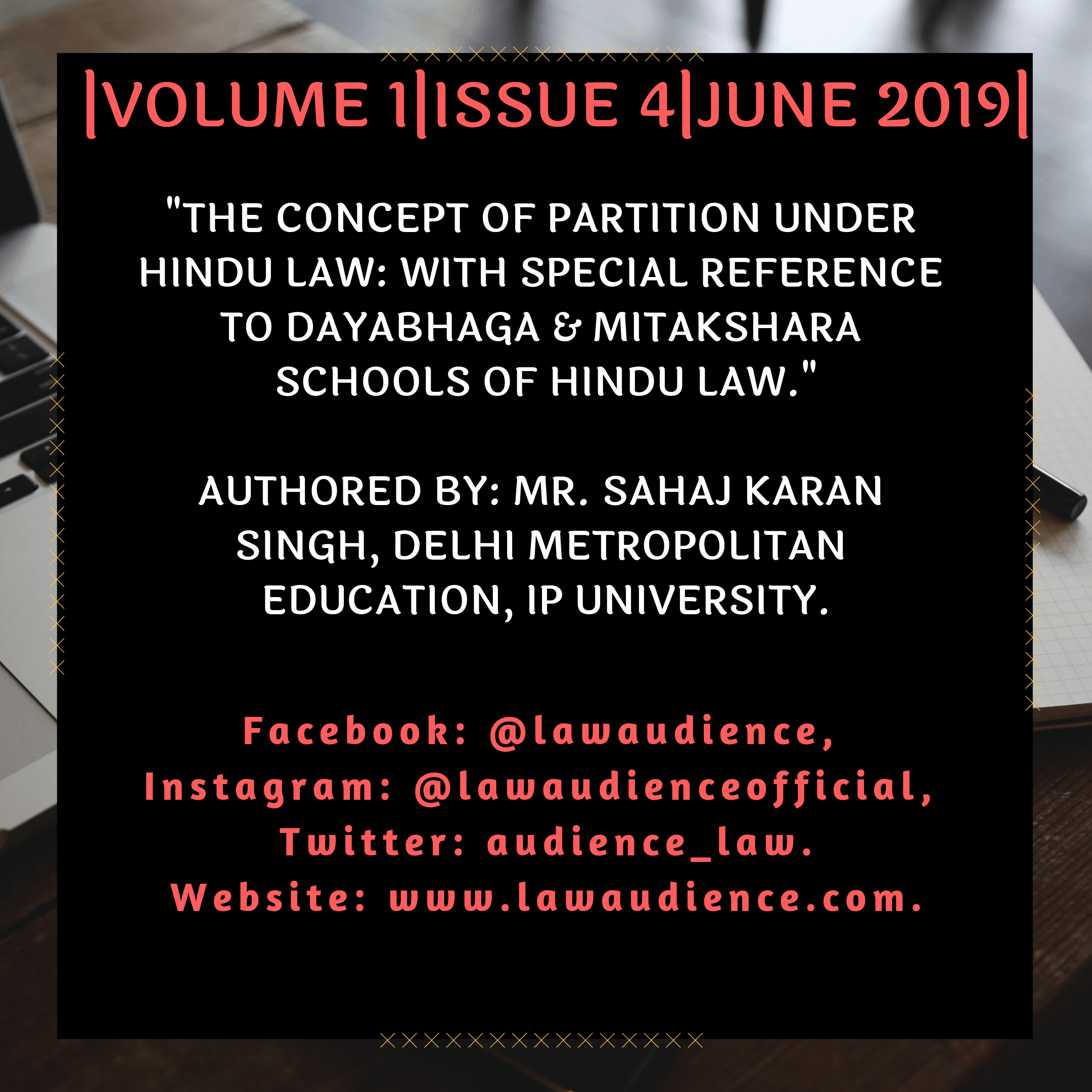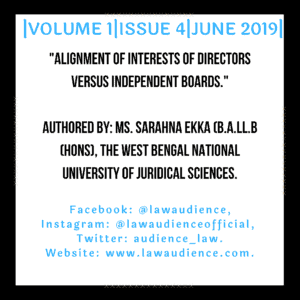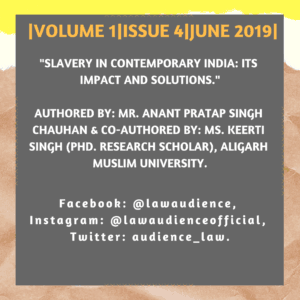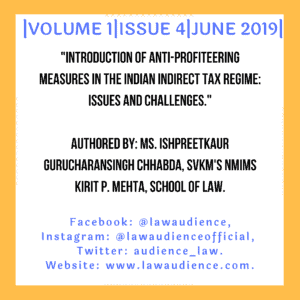Authored By: Mr. Sahaj Karan Singh, Delhi Metropolitan Education, IP University,
I. ABSTRACT:
“According to Webster’s Law Dictionary, the word “partition” means “a separation by a court of real estate owned jointly into two or more separately owned parcels, so that each of the former joint owners may enjoy having his or her own share in the estate”.[1] The article is divided into five phases wherein the first phase there is an interpretation of word partition by law dictionary, by the textual wordings of Smriti and old traditional Hindu law schools. The second phase is talking about the property which can be divided and which cannot be divided during partition. The third phase is regarding the entitlement of the coparceners that who can take a share in between the partition. The fourth phase is for partition in metes and bounds and partition in the severance of status and interest.
The last or the fifth phase is regarding reopening and reunion of the partition. The whole article is a conceptual and theoretical interpretation on “Partition in Hindu Law”.”
II. WHAT IS PARTITION?
Partition is “the act of dividing; esp. the division of real property held jointly or in common by two or more persons into individually owned interests”.[2] It is the division of a joint property especially the division of real and ancestral property held jointly by the coparceners can be divided amongst the coparceners. They can enjoy the physical individual share in the estate which is divided. Partition means bringing the joint family status to an end and every coparcener gets their own geographical portion in the former joint property.
III. PARTITION UNDER DIFFERENT SCHOOLS OF HINDU LAW:
III.I THE DAYABHAGA SCHOOL OF HINDU LAW:
When the partition is claimed or asked by any coparcener it states that there should be the division of property with giving specified shares of the coparceners, which means the share cannot fluctuate in ancestral property through the birth and the death of the coparcener. The shares are specified and ascertained or fixed in nature.
III.II THE MITAKSHARA SCHOOL OF HINDU LAW:
It does not mean the mere division of property into specified shares in between the coparceners. It means the division should be done like division of status, severance of interest or status, as this means the share can fluctuate in ancestral property through the birth and the death of the coparcener. Through birth, the share will decrease and through death, it will increase by its very nature. For examples, a) A has three sons, B, C and D. Each of them i.e. A, B, C and D will take ¼ shares in the joint family property. b) Coparcenaries consists of five brothers A, B, C, D and E, each of them on the partition will take 1/5 share.
IV. DIVISIBLE AND NON-DIVISIBLE PROPERTY DURING PARTITION:
Although the general rule is that the entire joint family property is available for partition, yet there may be certain species of joint family property which are by their very nature, incapable of division, then such properties cannot be divided. Manu stated that “a dress, a vehicle, ornaments, cooked food, water and female slaves, property destined for pious use and scarifies and a pasture ground, they declare to be indivisible”.[3] The common way, dwelling house, documents, right to way, staircase, well, tanks etc. have been also considered as indivisible.[4]
In respect to those properties three methods of adjustment are available:
- The property can be used in turns or enjoyed by coparceners jointly.
- The property may be allotted to the share of a coparcener and its value adjusted with the other property allotted to other coparceners.
- The property can be sold and sale proceeds distributed among the coparceners.
The temples, family shines and idols constitute such species of joint family property which can neither be divided nor be sold because of attachments, emotions, and rare items of property valuation. The possession of the temples, family shines and idols may be given to the senior coparcener with liberty to other coparceners to have an access to them for the purpose of worship[5] or may be used in turns[6] or to settle dispute the court can give this to pujari or mandir trust in which every coparcener having liberty to worship.
V. WHO ARE ENTITLE TO GET SHARE IN BETWEEN THE PARTITION?
The general rule says that every coparcener has a right to ask for his separate share in the joint family property, two conditions were recommended for this a coparcener who is asking for partition should be major and of sound mind. In Hindu Law, father, son, grandson, great-grandson, son born after partition but begotten before or during partition, adopted son, minor and daughter.
V.I FATHER:
The father does not have any right to partition in between himself and his sons but he has also the power to affect a partition among the sons inter se. The Mitakshara School expressly states that a father can divide his property if the partition was claimed and the partition will be done in between himself and his sons, here if any minor is present then he has to provide a separate and equal share to him also. An unequal partition or partition done without given the separate share to the minor, in these circumstances, a former coparcener can claim for re-opening of partition also.
V.II SON, GRANDSON, GREAT-GRANDSON:
Under Mitakshara School, son, son’s son and son’s son’s son is having right to ask partition but there is an exception in Bombay School it was stated that sons cannot ask for partition without the consent of his father if the partition was asked from grandfather. Under Dayabhaga School, there is no coparcenary consisting of the father and his sons and their sons have no right to claim or ask partition.
V.III SON BEGOTTEN AND BORN AFTER PARTITION:
The Hindu Law has laid down in his text that if a woman is pregnant, the equal share should be given to the child who is in the womb; whether a son or a daughter, he/she is equally entitled to hold a share in the joint family property. In case no share is reserved for the child or an unequal share is reserved for him, then after his birth, the next best friend or when he/she will become major can sue them in court and ask for re-opening of partition.
V.IV ADOPTED CHILD:
As this is an exceptional case and in this the, Hindu law divided it into two parts before and after 1956, before 1956 gave two situations:
(a) When there is another born aurasa i.e. natural son,
(b) When there is no born child.
In the first situation, the share of the property after partition differ from each other schools of law,
- In Bengal school – 1/3 of the estate’s share;
- In Benares school – 1/4 of the estate’s share ;
- In Bombay school – 1/5 of the estate’s share;
But after the codification of The Hindu Adoption and Maintenance Act, 1956,[7] the section 12 lays down that an adopted child will be treated same as a natural child, even in the partition and in other titles which are prescribed by law.
V.V MINOR:
The Hindu minor coparcener cannot ask for partition, but his share will be kept reserved, a suit for partition can be filled by a next friend on the behalf of minor only if the partition was not done properly or minor’s share was not reserved or an unequal share was given. There may be a situation when if a Karta did any transaction which may affect the share of a minor, a suit can be filled for re-opening of partition.
V.VI DAUGHTER:
In Pachi Krishnamma V. Kumaram,[8] in this case, the daughter claimed his share as equal as to the son in the partition of joint family property, but she was failed to prove her customs which says that a daughter can get an equal share as to the son. But after the amendment of 2005 in Hindu Succession Act, it gave the power that a daughter is having right to ask for partition and can claim an equal share as to the son in the partition of joint family property.[9][10]
In Prakash & Ors. v. Phulavati & Ors,[11]The Full Bench of the Bombay High Court in this case in Para No. 23 of the judgement held that: “Accordingly, we hold that the rights under the amendment are applicable to living daughters of living coparceners as on 9-9-2005 irrespective of when such daughters are born. Disposition or alienation including partitions which may have taken place before 20-12-2004 as per the law applicable prior to the said date will remain unaffected. Any transaction of partition effected thereafter will be governed by the explanation.”
In Danamma @ Suman Surpur & Anr. V. Amar & Ors,[12] The Hon’ble Supreme Court of India in this case as on 1st Feb 2018 held that: “Daughters Have Equal Rights In Ancestral Property, Even If They Were Born Before Enactment Of Hindu Succession Act.”
In Nayanaben Firozkhan Pathan @ Nasimbanu Firozkhan Pathan. Vs. Patel Shantaben Bhikhabhai & Others,[13] in this the Gujarat High Court as on 26/09/2017 held that a Hindu daughter after marrying to a Muslim guy does not lose her right to inherit property under The Hindu Succession Act.[14] HONOURABLE MR. JUSTICE J. B. PARDIWALA further observed that: “Prima facie, I am of the view that for the purpose of getting her name entered in the record of rights, all that was necessary to be indicated was, that the applicant is one of the Class-I legal heirs. It was not necessary for her to declare that she is married to a Muslim and she has embraced Islam by renouncing her Hindu religion. Once the question of law is answered in favour of the applicant, I do not see any good reason to lay much emphasis on the issue of an affidavit filed by the applicant.”
VI. PARTITION BY METES AND BOUNDS:
According to Black’s Law Dictionary, metes and bounds mean the territorial limits of real property as measured by distance and angles from designed landmarks and in relation to adjoining properties.[15] In other words partition by metes and bounds means a physical division of joint family property.[16] In old Hindu Law, the division of property in metes and bounds is divided into two parts Putra Bhaga and Patni Bhaga. Here Putra Bhaga means when the division of property is done by seeing the number of sons, and Patni Bhaga means of property is done by seeing the number of wives.
For examples, A has two wives P and Q, P is having three sons B, C and D, Q is having two sons Y and Z. If the property is divided according to the former rule of Putra Bhaga each son will get 1/5 share and if the property is divided according to the formerly given rule of Patni Bhaga then each wife will get a ½ share of the property. In Hindu Law, the rule of Putra Bhaga operates and the other rule is obsolete.
In a partition by metes and bound, the shares are allotted to coparceners on the basis of the following rules:
VI.I DIVISION BETWEEN FATHER AND SON:
When partition takes place between father and sons, the rule says that each son takes equal to the share of the father.
VI.II DIVISION BETWEEN BROTHERS:
When a coparcenary only consists of brothers, in this case when partition will be there in between brothers the rule says that each brother will get an equal share from the property.
VI.III DIVISION TAKES PLACES AMONG BRANCH:
When a coparcenary is divided amongst the branches, in this case when partition takes place the rule says that each branch takes Per Stirpes, as regards every other branch, and the member of each branch take per capita as regard each other.
- Per stirpes is a Latin word which means stock, in partition, it means proportionally divided between beneficiaries according to their deceased ancestor’s share.[17]
VI.IV DOCTRINE OF REPRESENTATION:
Under the Mitakshara School, coparcener’s share gets through the doctrine of survivorship but this doctrine has an exceptional doctrine also known as “Doctrine of representation” which says where a deceased coparcener leaves his heirs, then their heirs will take his share under this rule.
Under Dayabhaga School there is no room for these above-mentioned rules, the coparcenary comes into existences here after the death of father when son inherit and succeed to his property. The Doctrine of representation is there but with some modification, it does not extend beyond daughters. The daughters of the same class can inherit their father Per Stirpes.
VII. PARTITION BY SEVERANCE OF STATUS OR INTEREST:
Severance of status is quite distinct for De Facto division into a specific share of the joint property.[18] The former is a matter of individual decision, the desire to serve him and enjoy his hitherto undefined and unspecified share separated from other;[19] while the latter is a resultant consequent of his declaration of intention to serve but which essentially a bilateral action is. It may be arrived at by agreement by arbitration or by suit. Partition among members of the undivided family cannot be considered as disposition or conveyance or assignment or settlement. It is also not a transfer in a strict sense.
- De facto is a Latin word means in point of fact or existing in fact.[20]
VIII. RE-OPENING OF PARTITION:
The lawgiver Manu says in his text that if a partition takes place it is final and irrevocable which says that it cannot be re-opened[21]. On the other hand in his own text it was also written that “if after all the debts and assets have been distributed according to the rule, any property is afterwards discovered, one must divide it equally”.[22] It was also originated by katyayana that the property of which an unequal divided is contrary to law or the property recovered after being seized or lost should be redistributed between all coparceners.[23] This was also seen by the honourable courts that if above-mentioned conditions are there the partition should be re-opened. Generally, a partition can be reopened if it was taken that the partition takes place by fraud, coercion, misrepresentation or by undue influence.[24]
VIII.I FRAUD:
When the partition is done in a fraudulent way, when a worthless asset has been given to some coparcener as valuable assets or when a property is neither an ancestral property nor belongs to the family is given to a coparcener in partition or partition done in an unjust manner, the partition will be re-opened. It will be ordered to be set aside unless the person injured has acquiesced in it with full knowledge of facts.
VIII.II SON IN WOMB:
The Hindu Law has laid down in his text that if a woman is pregnant, the equal share should be given to the child who is in the womb; whether a son or a daughter, he/she is equally entitled to hold a share in the joint family property. In case no share is reserved for the child or an unequal share is reserved for him, then after his birth, the next best friend or when he/she will become major can sue them in court and ask for re-opening of partition.
VIII.III ADOPTED SON:
The codification of The Hindu Adoption and Maintenance Act, 1956, [25] the section 12 lays down that an adopted child will be treated same as a natural child, even in partition, if the share is not given or not divided equally, an adopted son of a deceased coparcener can ask for re-opening of partition.
VIII.IV MINOR COPARCENER:
The Hindu minor coparcener cannot ask for partition, but his share will be kept reserved, a suit for partition can be filled by a next friend on the behalf of minor only if the partition was not done properly or minor’s share was not reserved or an unequal share was given. There may be a situation when if a Karta did any transaction which may affect the share of a minor, a suit can be filled for re-opening of partition.
IX. REUNION OF PARTITION:
According to the Mitakshara, the reunion of partition is when the coparceners who have been divided earlier and again mixed together with their property.[26] According to the Dayabhaga, a reunion is only valid with a father, brother or paternal uncle.[27] The third person cannot come and reunite his property, for a reunion there should be a blood relation and a reunion can be made only between the parties to partition. These are mandatory which to be fulfilled for a reunion of partition. If a reunion can take place there the parties must be having an intention to reunite in interest and estate. It is with the conduct and understood in the concept of a reunion of partition that there should be an agreement to reunite between the parties. An agreement may be expressed in written or oral form or may be implied by conduct. The conduct must be in such a way which incontrovertible in character that an agreement of reunion must necessarily be implied therefrom. In other words, a reunion of the partition must be proved by convincing and cogent. As per the case of Privy Council, the court decided that a minor cannot reunite since a minor has no capacity to contract and a contract with minor is void-ab-initio.[28] [29] Void ab initio means null from the beginning as from the moment a contract is entered into. A contract is void ab initio if it seriously offends law or public policy, in contrast to a contract that is merely voidable at the election of one party to the contract. [30]
X. CONCLUSION:
The concept of ‘Partition’ under Hindu Law is a wider topic as compared to other laws. The rules of partition under the Hindu Law may vary from schools to schools. In this paper, the author has tried to explain the rules of partition under the Dayabhaga and Mitakshara Schools of Hindu Law. In simple word, the term partition means the separation of the share of the shareholder in the Join Family’s property. The person willing to get his/her separated from the Join Family Property has to communicate his/her intention to the competent authority as per the Hindu Law.
The article tries to cover the concept of partition; the research methodology employed in this study is ‘Doctrinaire’ The article is informative conceptual and theoretical interpretation and explanatory by its very nature and does not have any personal thoughts and opinion. It includes a review of literature available from law journals, case law references, periodicals, library, researches, books and internet.
[1] Webster’s Law Dictionary, 2006, Page 207.
[2] Black’s Law Dictionary, Edition 7, Page 1197.
[3] Manu, IX, 219.
[4] Mitakshara, I, IV, 25.
[5] Damodar vs. Utarmma, (1893) 17 Bom. 271 (India).
[6] Dattatraya vs. Prabhakar, 1937 Bom. 202 (India).
[7] The Hindu Adoption and Maintenance Act, 1956, No. 78, Acts of Parliament, (India).
[8] Pachi Krishnamma V. Kumaram, 1982 Ker. 137.
[9] L.H. Vidyapoornan vs. L.H. Premavathy, A.I.R. 2005 Mad. 193 (India).
[10] The Hindu Succession Act, 1956 No. 30, Acts of Parliament, (India).
[11]Prakash & Ors. vs. Phulavati & Ors, (2016) 2 S.C.C. 36) (India).
[12]DANAMMA @ SUMAN SURPUR & ANR. V. AMAR & ORS, (CIVIL APPEAL NOS. 188-189 OF 2018 [@SLP(C) Nos. 10638-10639 of 2013]) (India).
[13]Nayanaben Firozkhan Pathan @ Nasimbanu Firozkhan Pathan. vs. Patel Shantaben Bhikhabhai & Others, (SPECIAL CIVIL APPLICATION NO. 15825 of 2017) (India).
[14] The Hindu Succession Act, 1956 No. 30, Acts of Parliament, (India).
[15] Black’s Law Dictionary, Edition 7, Page 1055.
[16] Nanak Chand vs. Chand Kishore, 1982 Del. 520 (India).
[17] Black’s Law Dictionary, Edition 7, Page 1214.
[18] Elayat Karthiyayini Kunchi Amma vs. Minakshi Amma and Ors, 160 Ind Cas 594, (1936) 70 MLJ 114 (India).
[19] Abdul Basith Sahib vs. Shanmughasundaram and Ors, (1956) 1 MLJ 513 (India).
[20] Black’s Law Dictionary, Edition 7, Page 444.
[21] Manu, IX, 48.
[22] Maun, IX, 218.
[23] Smritichandrika XIV, 718.
[24] Ratnam Chettiar & Ors V. S. M. Kuppuswami Chettiar & Ors [1975] INSC 221.
[25] The Hindu Adoption and Maintenance Act, 1956, No. 78, Acts of Parliament, (India).
[26] Mitakshara, II, ix, 2, 3.
[27] Dayabhaga XII, 3-4.
[28] Balabux vs. Rukhmabai, (1903) 30 I.A. 130 (India).
[29] Section 11 of Indian Contract Act, 1872, No. 9, Acts of Parliament, (India).
[30] Black’s Law Dictionary, Edition 7, Page 1618.



